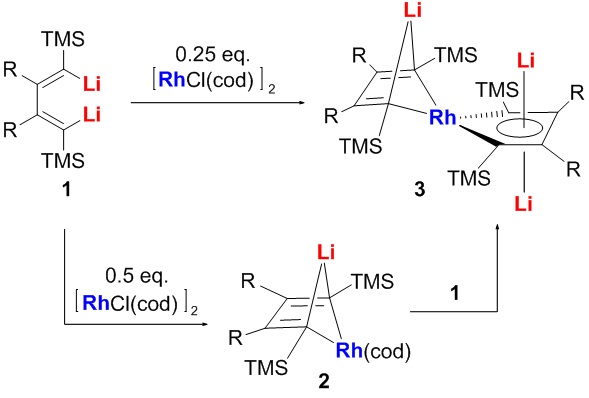研究室工作进展 Aug. 15th, 2015
1,3-Butadienyl Dianions as Non-innocent Ligands: Synthesis and Characterization of Aromatic Dilithio Rhodacycles
Junnian Wei, Yongliang Zhang, Wen-Xiong Zhang, and Zhenfeng Xi*
Angew. Chem. Int. Ed. 2015, 54, 9986-9990.(Very Important Paper)

Recently we reported the first example that organolithium reagents might behaved as formal oxidants (Angew. Chem. Int. Ed. 2015, 54, 5999-6002). In that reaction, 1,4-dilithio-1,3-butadienes (dilithio reagents for short) reacted with Ni(cod)2, offering aromatic dilithionickeloles as final products. Ni(0) was assumably oxidized to Ni(II) by the dilithio reagents based on XPS data. Excited by this fascinating discovery and at the meantime as our conclusion seems to have conflicts with classic theory of formal oxidation state formalism, we tried to have more examples and evidences to discuss this topic more deeply and systematically.
Here we report that 1,4-dilithio-1,3-butadienes, a type of 1,3-butadienyl dianions, can act as non-innocent ligands, taking electrons from low-valent transition metals. Dilithio reagents reacted with [RhCl(cod)]2 to offer dilithio rhodacycle. Single-crystal X-ray structural analysis revealed the structure with averaged bond lengths. XPS data suggested that the oxidation state of Rh was more likely to be Rh3+. CDA/ECDA confirmed the electron transfer process. 7Li NMR spectra and theoretical calculations revealed a considerable aromatic character. In this process, the dilithio compounds behaved as non-innocent ligands and formal oxidants. These results further demonstrated that organolithium compounds with suitable π-conjugation could be used as electron acceptor.
亮点介绍
碳负离子可以作为氧化剂继续接受电子
在已知的氧化还原反应中,碳负离子如常见的有机锂试剂可能作为还原剂而失去电子,但是不作为氧化剂进一步得到电子。本课题组魏俊年同学利用我们自己发展的双锂试剂及其协同效应,与低价过渡金属配合物如Ni(cod)2和[RhCl(cod)]2反应,合成了相应的芳香性金属杂环戊二烯衍生物(For Ni,see: Angew. Chem. Int. Ed. 2015, 54, 5999-6002)。在该反应中,双锂试剂的丁二烯基双碳负离子共轭体系的反键轨道与低价过渡金属的d轨道中的一对电子产生“协同效应”,使富电荷的丁二烯骨架继续获得电子,成功构建了具有芳香性的金属杂环戊二烯衍生物。该研究打破了传统所认为的碳负离子不能够继续获得电子的认知,为共轭体系碳负离子化学的进一步发展和应用提供了一个全新的思路。
单晶结构和理论计算证实了所生成的金属杂环戊二烯衍生物具有显著的芳香性。X-射线光电子能谱显示过渡金属的氧化态显著上升(Ni近似+2价,Rh近似+3价)。由于双锂试剂中碳负离子与丁二烯骨架的协同效应,其LUMO轨道能级相对于1,3-丁二烯显著降低,故一些过渡金属的d轨道电子可离域至双锂试剂的π*轨道,完成芳香性金属杂环的构建。双锂试剂在该反应中可视为一类特殊的non-innocent ligand或者redox-active ligand,发生了氧化还原反应。
该系列工作也是本课题组双金属有机合成试剂化学的新展开。
